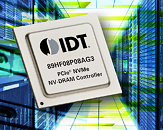Thursday, September 6th 2012
IDT Announces World's First PCI Express Gen 3 NVMe NV-DRAM Controller
Integrated Device Technology, Inc. (IDT), the Analog and Digital Company delivering essential mixed-signal semiconductor solutions, today announced the industry's first NVM Express (NVMe) enterprise non-volatile DRAM (NV-DRAM) controller with native support for PCIe Gen 3. The new NVMe NV-DRAM controller expands upon IDT's previously announced NVMe flash controller family to provide standards-based, high-density, high-performance PCIe-attached NV-DRAM solutions built around a combination of DRAM and NAND flash devices.
The IDT 89HF08P08AG3 NV-DRAM controller supports up to 32 GB of DDR3 SDRAM and 8 channels of NAND flash, with a PCIe x8 Gen 3 host interface. The controller is designed to fully comply with the NVMe standard - a standard that defines an optimized register interface, command set, and feature set for PCIe-based solid-state drives (SSDs). IDT's new PCIe NV-DRAM controller enables unparalleled read and write random performance with extremely low latency and high endurance, making it ideal for storage-intensive enterprise-class applications. The programmable controller provides OEMs the flexibility to quickly develop and deploy NV-DRAM solutions that use standard NVM Express drivers."IDT continues to be at the forefront of NVMe PCI Express controller innovation. The new NVM Express NV-DRAM controller follows the industry's first NVMe enterprise flash controller announced in August," said Kam Eshghi, senior director of marketing of the Enterprise Computing Division of IDT. "IDT's family of NVMe flash and NV-DRAM controllers dramatically boosts the number of random I/O operations per second (IOPS) that a system can process. At the same time, the devices eliminate the traditional SAS and SATA storage infrastructure and thereby reduce latency, power and cost. NVMe is enabling a paradigm shift occurring in enterprise architectures and IDT's NVM Express controllers play a central role."
The 89HF08P08AG3 NV-DRAM controller reads and writes data directly into DDR3 DRAM at speeds of up to 3 GBps. When the 89HF08P08AG3 controller detects power-down, the DRAM contents are backed up into NAND flash. With up to eight NAND flash channels and eight targets per channel, this backup operation can be performed with a write bandwidth of up to 1 GBps, depending on flash type and number of targets utilized. The 89HF08P08AG3 supports up to 32GB of DDR3 SDRAM, with configurable data rate from DDR3-800 through DDR3-1600. The datapath is 72 bits wide (64 b data and 8 b ECC) with four ranks, and it supports x8 and x16 SDRAM data widths.
As with IDT's PCIe flash controllers, the new PCIe NV-DRAM controller is fully programmable, enabling customers to differentiate their solutions with custom firmware that leverages IDT's reference firmware. In addition, IDT's 89HF08P08AG3 provides the data integrity and reliability features expected in enterprise-class solutions.
For more information, visit this page.
The IDT 89HF08P08AG3 NV-DRAM controller supports up to 32 GB of DDR3 SDRAM and 8 channels of NAND flash, with a PCIe x8 Gen 3 host interface. The controller is designed to fully comply with the NVMe standard - a standard that defines an optimized register interface, command set, and feature set for PCIe-based solid-state drives (SSDs). IDT's new PCIe NV-DRAM controller enables unparalleled read and write random performance with extremely low latency and high endurance, making it ideal for storage-intensive enterprise-class applications. The programmable controller provides OEMs the flexibility to quickly develop and deploy NV-DRAM solutions that use standard NVM Express drivers."IDT continues to be at the forefront of NVMe PCI Express controller innovation. The new NVM Express NV-DRAM controller follows the industry's first NVMe enterprise flash controller announced in August," said Kam Eshghi, senior director of marketing of the Enterprise Computing Division of IDT. "IDT's family of NVMe flash and NV-DRAM controllers dramatically boosts the number of random I/O operations per second (IOPS) that a system can process. At the same time, the devices eliminate the traditional SAS and SATA storage infrastructure and thereby reduce latency, power and cost. NVMe is enabling a paradigm shift occurring in enterprise architectures and IDT's NVM Express controllers play a central role."
The 89HF08P08AG3 NV-DRAM controller reads and writes data directly into DDR3 DRAM at speeds of up to 3 GBps. When the 89HF08P08AG3 controller detects power-down, the DRAM contents are backed up into NAND flash. With up to eight NAND flash channels and eight targets per channel, this backup operation can be performed with a write bandwidth of up to 1 GBps, depending on flash type and number of targets utilized. The 89HF08P08AG3 supports up to 32GB of DDR3 SDRAM, with configurable data rate from DDR3-800 through DDR3-1600. The datapath is 72 bits wide (64 b data and 8 b ECC) with four ranks, and it supports x8 and x16 SDRAM data widths.
As with IDT's PCIe flash controllers, the new PCIe NV-DRAM controller is fully programmable, enabling customers to differentiate their solutions with custom firmware that leverages IDT's reference firmware. In addition, IDT's 89HF08P08AG3 provides the data integrity and reliability features expected in enterprise-class solutions.
For more information, visit this page.

10 Comments on IDT Announces World's First PCI Express Gen 3 NVMe NV-DRAM Controller
hrm....:wtf:
PRice? Only $15,999.99!!!
:roll:
PCIe 3.0 x16 is 128GT/s, perhaps that's what you were thinking about.I believe most controllers fall into that category :)
The customers they're referring to in the PR are the OEMs building solutions around this chip (such as my 128GB monster SSD with quad-controllers), not end-users with retail products.
INB4: half-duplex.You would have... enough :D
:D
1 GB/sec is PCIe 2.0, with 5.0 GT.
www.pcisig.com/news_room/faqs/pcie3.0_faq/
Yes, I'm being a bit facetious here, and you do not need to point it out. :p I like to play games!
And yes, I brought it up for a reason. :p
Add in the PLX PEX8747..how much bandwidth would ya get?
supremelaw.org/systems/nvme/want.ad.htm
... with this cabling topology:
... or motherboards with the same 4 x U.2 ports.
There is certainly room on standard ATX motherboards
e.g. see examples with multiple SATA-Express connectors:
MRFS